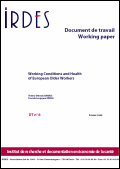
WORKING PAPERS 2012
WP n° 53
The basic DRG-payment model does not provide direct incentives to hospitals to im- prove the quality of care provided. However, it can be modified to: give explicit incentives for higher-quality treatments; penalise “bad quality care”; or improve care process and patient outcomes by granting funds for progress made. Therefore DRG-based payment may represent risks but also provides opportunities for improving care quality in hospitals. This requires continuous refinement of data and the monitoring of care quality as well as treatment costs. However, in many countries, information on patient outcomes and process quality is still not routinely collected. |
WP n° 52
Using four waves of panel data from the Survey on Health, Ageing, and Retirement in Europe (SHARE), a frailty index is created as a count measure for five physiologic criteria (Fried model) for respondents aged 50+ in 10 European countries, between 2004 and 2011. The longitudinal dimension is explored in two ways. First, differences in frailty dynamics over a seven-year-time period are analysed through variables that are relevant for social policy (income maintenance, housing adaptation, and prevention of social isolation) in a panel model for count data with fixed effects. Second, the individual fixed effects are decomposed by means of a random effects model with Mundlak specification. SHARE additional retrospective data on life history (SHARELIFE) are then used to investigate differences in frailty levels. The results reveal the presence of various sources of social inequalities over the life-course. Social Protection Systems thus appear to play a major role in accompanying, preventing or reducing the frailty process. Several policy implications are suggested. |
WP n° 51
In this research, we put into question the measure of spatial accessibility to general practitioner. Using recent advancements in health geography of primary care, we propose to apply the ‘Two-step floating catchment area' method to the French context of care. This indicator allows us to consider health supply and demand as well as geographic accessibility simultaneously. But basic computation of this indicator presents some limitations we attempt to deal with. We propose to improve the measure of accessibility to primary care in three directions: definition and quantification of the supply, integration of health care needs on the demand side and a more accurate definition of interaction between both. Finally, this measure of local potential accessibility renews classical approaches of accessibility to primary care in France and deals with local problems of healthcare resources to needy population. |
WP n° 50
After briefly reviewing the various determinants for the effect of composition and the effect of context, as well as sick leaves and their importance for understanding geographic differences, we present a three-phase empirical analysis: a descriptive analysis to detect differences between departments, a multivariate analysis to highlight explanatory factors of probability of being on sick leave and, finally, an analysis of determinants of differences between departments. Our different models explain a signifi cant portion of the disparities between departments. The effects of composition and effects of context account for approximately two-thirds of the mean squared error. The variables describing the medical supply (density of general practitioners), monitoring by National Health Insurance and patient age when the professional career began best explain the disparities between departments concerning sick leave. In contrast to other compositions or contexts included in our model, the percentage of sick leaves verified and the density of general practitioners are important factors with respect to health policies. Our research shows that they could be used as public policy instruments aimed at reducing geographic disparities. |
WP n° 49
|
WP n° 48
|
WP n° 47
|
WP n° 46
|
WP n° 45
|
WP n° 44
|
WP n° 43
Results show that in a group, me-too drugs are on average 59% more costly than firstin-class. In a given group, more innovation is associated with higher price gaps. On the contrary, arrival of generic drugs on the market or the fact that drugs are included in reference price groups (so-called “Tarif Forfaitaire de Responsabilité” [TFR] in France) tend to reduce the price gaps between me-too drugs and first-in-class. For those drugs that are available in several dosages, monotonic pricing, i.e. a price which is proportional to dosage, leads to higher price discrepancies and can be considered as unfair for patients who have to buy higher dosages. Finally, price gaps increase with drugs market shares, which contrasts with the price rule announced by the regulator. This document supersedes:
|


